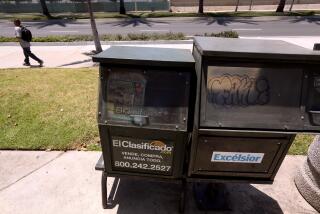WHAT ELSE IS NEWS? : What You See Is What You Get, but There’s Always More Where That Came From
- Share via
When I was a kid, I had to go to bed before it came on, but I could hear the theme song to “Car 54, Where Are You?” jangling from the television in the living room:
“There’s a holdup in the Bronx, Brooklyn’s broken out in fights, there’s a traffic jam in Harlem that’s backed up to Jackson Heights, there’s a Scout troop short a child, Khrushchev’s due at Idyllwild .
But I’m not in New York, and it isn’t 1963. L.A.’s police scanner sings less innocently of killers and kidnapers. Its thin blue line is spread like peanut butter before payday. And 911 will have to start charging $3.99 a minute, same as the Psychic Friends Network.
And what about us, the thin news line? The LAPD numbers about 7,400; the LAPC--Los Angeles press corps--is just over half that. The urban journalist’s predicament is akin to the urban cop’s: only so much time and only so many bodies to get the job done.
Assembling a day’s newspaper is no formula; it’s a painterly rendering of a few scenes culled from many. Contenders pour in by fax, phone, mail and wire service. Speeches. Seminars. City Council meetings. Hollywood premieres. Like caged puppies at the pound, PR people clamor to catch the editor’s eye.
Women in a self-defense course will be “mugged” to raise money so poor and abused women can also get the training . .. Paleontologist-to-the-stars Robert Bakker leads a staged dig for dinosaur bone replicas to promote the Rose Parade float theme . .. Burbank police have surrounded an apartment building where neighbors have complained about a woman who hasn’t committed a crime but who won’t come out of her apartment .
Enough real and contrived news for 10 cities. Too much of any of it--like too much red or blue on a canvas--and the day’s paper can tip out of scale. Take crime. For all the public mutterings about too many crime stories, we report only a fraction of all that happens. To load every page with crime sagas would benumb readers. To underplay them would be to lie.
I don’t give much credence to media-conspiracy theories. The truer failing is the frustration that comes from riding the hamster-wheel that is the nature of the news beast: This is a newspaper, not a census, and we can’t write about everybody every day. So we may end up writing about one homeless woman, one unemployed aerospace worker or one plucky store owner--as being emblematic of many. One day’s story about one suffering family may bring the TV cameras, the checks and the jobs, while the equally deserving family next door gets nothing.
Last year, every time a child younger than 15 was killed in Chicago, the Tribune wrote a major story about it. Did people get angry or bored? I’m afraid if we covered everything, stories would cease to mean anything. Look, here’s another story about a promising kid killed by a gang on the steps of the public library--which was closed from budget cuts--as he waited with his little sister for their unemployed but undaunted father to pick them up to take them to their grandmother’s 90th birthday party. Why can’t the news media give it a rest? Pass me some more French toast .
That’s another thing: It has pained me to watch the city’s tolerances, like its defenses, ratcheting upward over the years. What used to be shocking is now commonplace--and that fact, too, is newsworthy. Ten years ago, a teen killed in gang cross-fire was a story. Now it takes a girl carried off from a slumber party in her own bedroom to get seen and heard and read above all the other mayhem that has become ordinary.
And being new is a relentless part of being news . Like cops at a crime scene, when the phone rings or the alarm summons, we may be sent off to another story, sometimes before every question can be answered about the last one.
The next day, we build from zero again, stirring the doings of the powerful, the criminal, the unfortunate, the brave, the humble and the quirky into the mix. One day’s newspaper is layered atop the previous day’s, and over time, we hope that it begins to look, sound and read not like some court docket or movie script or video game, but like a city, the one we live in.
More to Read
Sign up for Essential California
The most important California stories and recommendations in your inbox every morning.
You may occasionally receive promotional content from the Los Angeles Times.














